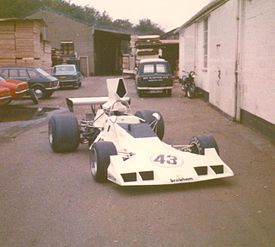 Photograph of Brabham BT43 F5000 car taken by Bob Paton on debut in 1973 shown outside Motor Racing Developments Weylock Works, New Haw, Surrey UK | |
| Category | Formula 5000 |
|---|---|
| Constructor | Motor Racing Developments |
| Designer(s) | Geoff Ferris |
| Technical specifications[1] | |
| Chassis | Aluminium monocoque with diffused Steel and Aluminium fittings. Non-load bearing engine in fabrication between monocoque and transmission. |
| Suspension (front) | Independent, upper asymmetric wishbone, upper mid mounted tubular anti-roll bar, mid mounted rack and pinion steering rack, lower symmetric wishbone, inclined coil spring/shock absorber units, outboard ventilated disc brakes, 13 x 10 wheels |
| Suspension (rear) | Independent, high mounted tubular anti-roll bar, upper and lower trailing arms with single upper link and reversed lower "A" arms, inclined coil spring/shock absorber units, inboard ventilated disc brakes, 13 x 17 wheels |
| Axle track | Front: 56.0 in (1,420 mm) Rear: 60.0 in (1,520 mm) |
| Wheelbase | 99.5 in (2,530 mm) |
| Engine | mid-engine, longitudinally mounted, 4,940 cc (301.5 cu in), Chevrolet, 90° V8, NA |
| Transmission | Hewland DG300 5 Speed and Reverse Transaxle manual transmission LG Cam and Pawl or Salisbury type differential |
| Weight | 612 kg (1,349 lb) |
| Fuel | 25 Gallon |
| Tyres | Goodyear, Firestone, or Dunlop |
| Competition history | |
| Notable entrants | Adlards Crowne Racing Adlards Chuck Jones Shellsport Roadstar NSW Thompsons Motor Auctions Nine Wide World of Sports |
| Notable drivers | |
| Debut | 1974 |
The Brabham BT43 was the only Formula 5000 racing car built by Motor Racing Developments (MRD).[2] Initiated by Ron Tauranac, designed by Geoff Ferris, and built by a team including Nick Goozee (monocoque) and Bob Paton (construction), it was one of the last cars produced by MRD before MRD was closed by the then new Brabham owner Bernie Ecclestone.[3] Based on the Formula Two Brabham BT40 (which was also designed by Geoff Ferris) the BT43 featured a modified monocoque that incorporated the triangular cross section pioneered by the Brabham BT42 Formula One car which was designed by Gordon Murray. This distinctive pyramid shape not only kept the aerodynamic "stagnation point" low but also neatly allowed the incorporation of a "crushable structure" as required by the 1973 regulations which specified that all fuel tanks were to be protected by deformable structures.[4] Engine and gearbox were the then de facto F5000 standard combination of a Chevrolet 302 cubic inch engine in an unstressed mounting and a Hewland DG300 gearbox. The fitment of these into what was a relatively small Formula Two sized car presented some design challenges.[3] Front suspension components were BT40 while rear suspension components were a combination of Formula One and BT40.[3]
Rolled out in October 1973 and photographed by renowned motoring photographer David Phipps;[5] the BT43 was initially tested at Silverstone by John Watson.[6][3] This initial testing revealed a distinct lack of front end downforce.[3]
- ^ Original Brabham Document handwritten by Gordon Murray.
- ^ "Ron Tauranac Official Website – Designer of the Brabham and Ralt marques". rontauranac.com.au. Archived from the original on 26 October 2017. Retrieved 4 February 2016.
- ^ a b c d e "The strange tale of the F5000 Brabham BT43 - Page 2 - The Nostalgia Forum". The AUTOSPORT Forums. Retrieved 4 February 2016.
- ^ Henry, Alan (1985). Brabham: The Grand Prix Cars. Printed in Holland: Hazleton Publishing, Richmond, Surrey. p. 137. ISBN 0-905138-36-8.
- ^ "Original Photo of Brabham BT43 taken at Rollout by David Phipps".
- ^ "Brabham's stylish BT43 F5000". Motoring News. 25 October 1973.